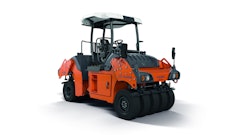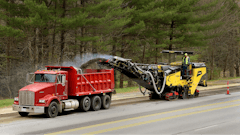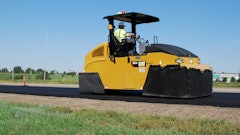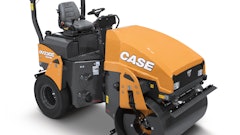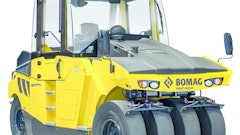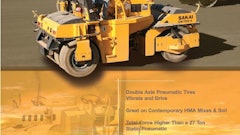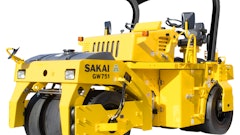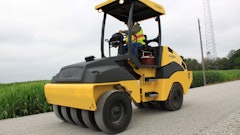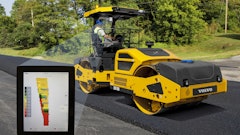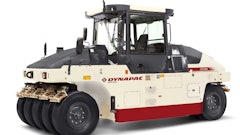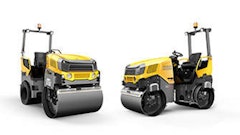
When it comes to asphalt roller maintenance, the old adage "an ounce of prevention prevents a pound of cure" applies, says Tom Meyer, manager of marketing and sales support with Vibromax America Inc.
"Poor maintenance may result in a breakdown while the unit is on the job," says Meyer. "You'll incur downtime and have the added expense of repairing the unit at the jobsite or transporting a replacement unit."
Steven Spence, compaction product manager with Multiquip, agrees, noting, "Failing to maintain asphalt rollers keeps them in the shop, not on the job."
Not only will regular maintenance of your asphalt rollers keep them performing, it will also extend the life of the machine and provide a greater return on your investment.
"Neglecting regular maintenance can result in hard engine starting, poor performance or system failure," says Dave Dennison, service manager with Bomag Light Equipment.
In order to minimize downtime, reduce service costs and lower your cost of ownership, there are a several key systems to keep in mind when it comes to maintaining your one- to 2.5-ton asphalt rollers: power system, hydraulic system, sprinkler system, vibratory system and safety system. "Failure of any one of these systems will result in machine downtime," says Dennison.
Power system
The power system ' or power plant ' is the system that keeps the whole machine moving. With regard to the engine, the engine cooling system should be inspected, and the oil and filter should be replaced every 150 hours.
Hydraulic system
One of the most common problems with asphalt rollers is hydraulic system contamination. You should always follow maintenance and repair manual procedures for maintaining and servicing the hydraulic system. Here are some other suggestions for maintaining the hydraulic system:
- Hydraulic oil should be checked daily using the sight gauge on the reservoir. Check the oil level when the hydraulic oil is at a "normal" operating temperature only. Add hydraulic oil as required and change the oil every 2,000 hours/two years of operation or as indicated by laboratory oil analysis. Some manufacturers recommend changing the hydraulic oil every 1,000 hours or annually. Always be sure to check your owner's manual for the proper interval for your brand of roller.
- Hydraulic oil filters should be changed as needed or every 2,000 hours, but they should be inspected daily.
- Inspect all hoses each day for any rub-throughs, punctures, leaks, etc. Strictly adhere to the hose pressure ranges prescribed by the manufacturer.
Sprinkler system
The sprinkler system should be checked every 100 hours of operation according to sources. Here are some key areas of the sprinkler to check:
- Nozzles should be checked frequently to make sure they haven't become plugged. Remove, clean and reinstall nozzles as necessary.
- Water spray suction strainers are available on some rollers. They should be removed, checked and cleaned every 500 hours or at least once a year.
- Also check for broken or loose cleaner bar beams and/or rubber cleaner components. An inspection should be made every 50 hours or at least once per week. Replace broken or missing parts.
Vibratory system
There are several maintenance items to consider with your roller's vibratory system:
- Drum buffers should be checked every 100 hours of operation.
- Drum vibration frequency should be checked every 500 hours.
- The oil in the vibratory system should be changed every 1,000 hours.
Also, as with all vibratory equipment, the roller's hardware needs to be retightened from time to time, and any missing hardware needs to be replaced.
Safety system
Safety systems, as always, are crucial to proper roller operation and shouldn't be neglected.
While all safety points need to be inspected, the brakes on a roller should never be overlooked. Be sure to check the secondary or parking brake system for proper operation on a daily basis.
Other safety suggestions include:
- Inspect the bolts that fasten the ROPS/FOPS structure to the roller; tighten them to the torque setting recommended by the manufacturer.
- Inspect all welds for cracks, breakage, rust or other problems. If any damage is found, contact your supplier immediately.
- Check other safety related items, such as seat belts and safety decals/placards, to be sure they're in proper working order.
Daily housekeeping
According to sources, there are some housekeeping tasks that should be performed daily before roller operation begins.
"Fluid levels need to be checked on a daily basis," says Meyer with Vibromax. "The hydraulic reservoir, engine oil level and fuel level should be checked before beginning operations. A complete walk-around inspection, which should include all safety-related items, should also be performed."
Daily fluid checks are vital to a properly functioning asphalt roller. With a simple daily check of fluid levels, you'll find small problems before they become big problems. For example, if the roller is using a lot of oil, you can find out what's causing the usage before the whole system shuts down.
Other important items to keep a sharp eye on include drum scraper condition, greasing the articulation joint, rubber buffers (between the drum and frame) condition and draining the fuel pre-cleaner or water separator.
The best way to avoid costly mistakes and keep your asphalt rollers in tip-top shape is to follow a systematic, preventive maintenance schedule. Whether it's manual or from a computer, sticking to the manufacturer recommended maintenance checklist is the best and easiest way to keep your rollers up and running.
"Properly maintained machines perform better and cost less to operate than those that are neglected," says Jeff Fox, product/marketing manager with Ammann America Inc. "Not following the manufacturers recommended service interval chart can result in the premature failure of expensive components as well as extended downtime while major repairs are completed."
Keep them rolling after winter
Now is the time of year when you need to think about winterizing your asphalt rollers for cold weather storage. If you plan on putting your units in moth balls for the winter (or storing for more than 30 days) follow these steps:
- Clean the machine.
- Paint any areas that have chips or missing paint.
- Prepare the fuel tank. Some sources prefer draining the fuel tank; others say to fill the fuel tank completely and treat it with a fuel preservative. It's always best to read your unit's owner's manual for manufacturer recommendations.
- Change the engine oil and replace the engine oil filter.
- Service the air filter.
- Completely drain the water tanks, water supply lines and spray bars of water. Apply low compressed air to these parts to remove any water still remaining in them. The best method to eliminate freeze damage is to drain the system as far as possible then run just enough propylene-glycol (engine anti-freeze) through the system to flush out any residual water. Remove the water pump assembly, completely drain all remaining water from the pump and reinstall the pump on the roller. Put a plastic cover or tape over each water spray nozzle.
- Cap, tape or otherwise seal all openings such as the air cleaner and exhaust to prevent entry of moisture (or small animals looking for a warm home).
- Loosen or remove the engine drive belts.
- Coat the steering cylinder rod with a corrosion-preventive treatment.
- Remove the battery and clean, charge and store in a cool place. Charge the battery again every 30 days.
- Attach a DO NOT OPERATE sign on the machine. Remove the ignition key; put it in a safe place.
- Cover the machine to protect it.
If the unit will be used in the winter months, it's still a good idea to prepare it for colder weather. You might want a lighter viscosity fluid for cooler temperatures, and you might want to add antifreeze to some of your systems. Remember to always follow the manufacturer's recommended procedures for proper storage.





